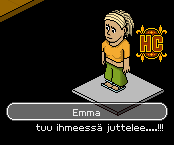
Community Model |
Example 3: Improving a personaA persona is usually a stereotypical and always hypothetical user archetype or profile in a community. Persona-related design guidelines (Cooper 1999)You should include
(See some journals for wider considerations around guidelines)
Persona done by the normal guidelines Emma is 13 years old and has been an active Habbo user for 2 years. Normally she logs on to Habbo after school, except for Tuesdays when she goes horseback riding and Thursdays when she has her piano lesson. When she first started using Habbo, the family computer was in her dad's home office room, but nowadays she can log on whenever she wants because she has a computer in her own room. Her dad got tired of her frequent requests to visit Habbo, so he bought a new computer and gave Emma the old one.  In Habbo she has found a very good way to make new friends. She has decorated her room like a talkshow, with a desk and chair for her as the host, a sofa for the guests on the show, and some chairs for the audience. Usually she invites her firends from school, but recently she has started inviting some of her new Habbo friends too. She encourages everyone to bring their friends along too, so that there will be enough people in the audience for her magnificient show. Principles of improvementsAs in the examples one and two, also here the social world frames and contextual attributes are relevant ones. For example, we can look at this case as the question of Primary activity. Generally, in Habbo Hotel the primary activity can be understood as ''room decoration'' (at least for some habbos). Now, particularly this seems to be the case with Emma. However, with the help of the model we can scrutinize her contextual motivation more deeply. Which are her intermediate goals, and which is her ultimate goal? Is it to use her room alone or in the group? Furthermore, when creating a community persona, for example, we should note
For example, the level of publicity. In the Habbo Hotel, a persona could be thought as
Sociability criteria can be used when the persona is communicating with others. Is it telling its personal secrecies (breaking thus the lower threshold of sociability), or is it bragging by its objective success (braking thus the upper threshold) in Habbo, such as furny (Habbo slang for furniture) and friends. Or, is it chatting with others because of fun (staying thus in between the thresholds), or in order to gain some marks of success (breaking the upper threshold). The model-boosted version (additions shown by italics) Emma is 13 years old and has been an active Habbo user for 2 years. Normally she logs on to Habbo after school, except for Tuesdays when she goes horseback riding and Thursdays when she has her piano lesson. When she first started using Habbo, the family computer was in her dad's home office room, but nowadays, as an only child in the family, she can log on whenever she wants because she has a computer in her own room. Her dad got tired of her frequent requests to visit Habbo, so he bought a new computer and gave Emma the old one. By keeping the door between the living room and Emma's room open, her mother tries to monitor and restrict the hours she spends in Habbo. Emma thinks her room is a private place, so she usually closes the door anyway.  In Habbo she has found a very good way to make new friends. She has decorated her room like a talkshow, with a desk and chair for her as the host, a sofa for the guests on the show, and some chairs for the audience. Usually she invites her firends from school, but recently she has started inviting some of her new Habbo friends too. She encourages everyone to bring their friends along too, so that there will be enough people in the audience for her magnificient show. Emma believes that when her Habbo room is not so private but more in between private and public, guests are more willing to come and stay. Mostly she likes habbos who never brag by the amount of their furni. The worst are those, she thinks, who immediately tell their deepest secrets and bad feelings. The intermediate goal of Emma is to get friends in Habbo, but her ultimate goal is, anyhow, to become famous. She believes that it is possible if she gets as many habbos as possible to visit her room. * Disclaimer: We are aware that the additions to the first part of the persona description – about the home relations – hardly will result in any improved design concepts inside the Habbo Hotel. But, if the concept is enlarged and Habbo extends, these kinds of persona additions might become relevant. Community needs revealed/Contribution to designExplicit needs: make friends and become known Implicit/realised by model: (for example) certain privacy arrangements and truly sociable conversations, the difference between intermediate and ultimate goals. In case of children users, rules of behaving (such as the Habbo way) might be improved by the sociability criteria.
By mikael at 2006-02-23 21:40
|